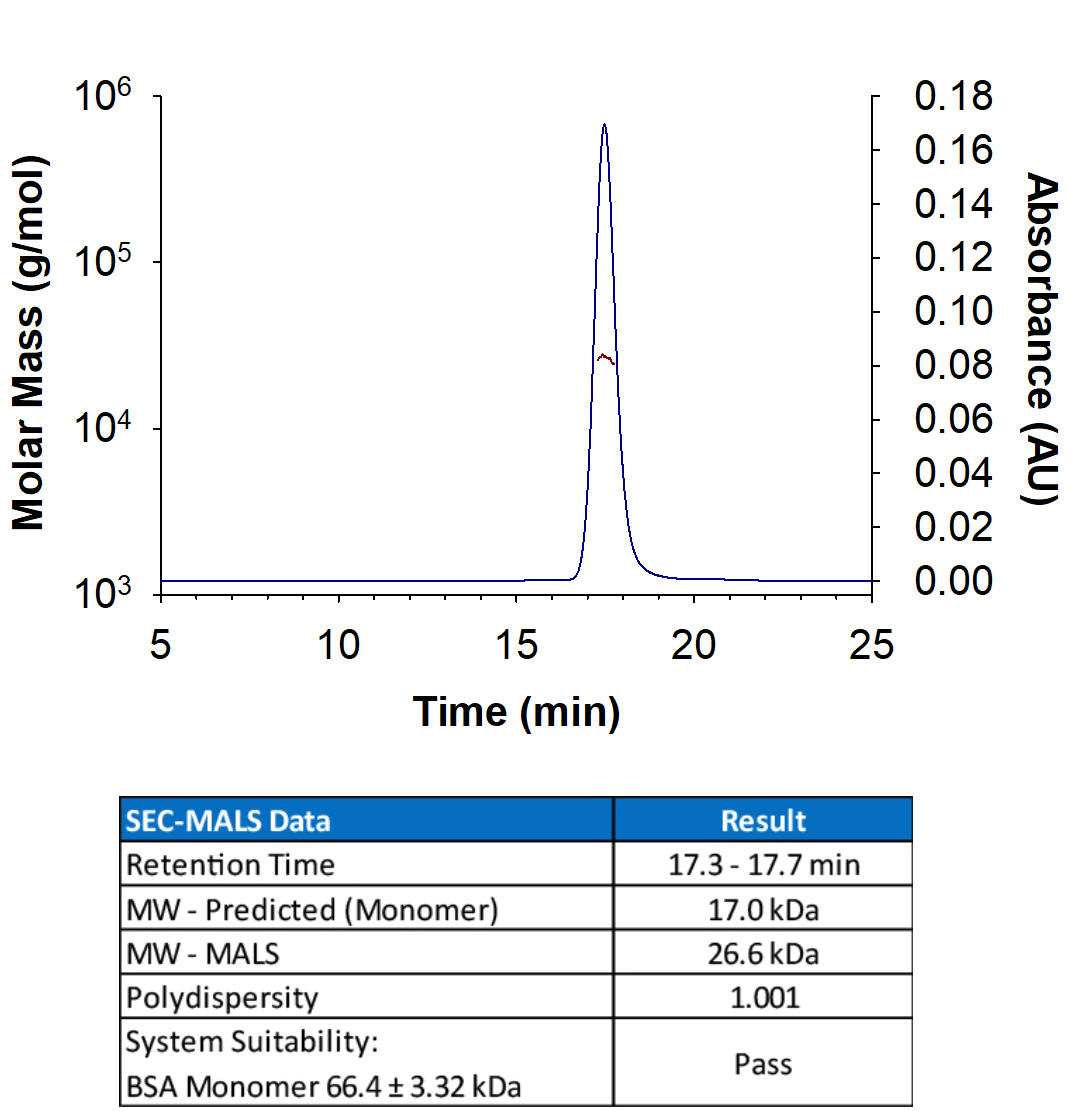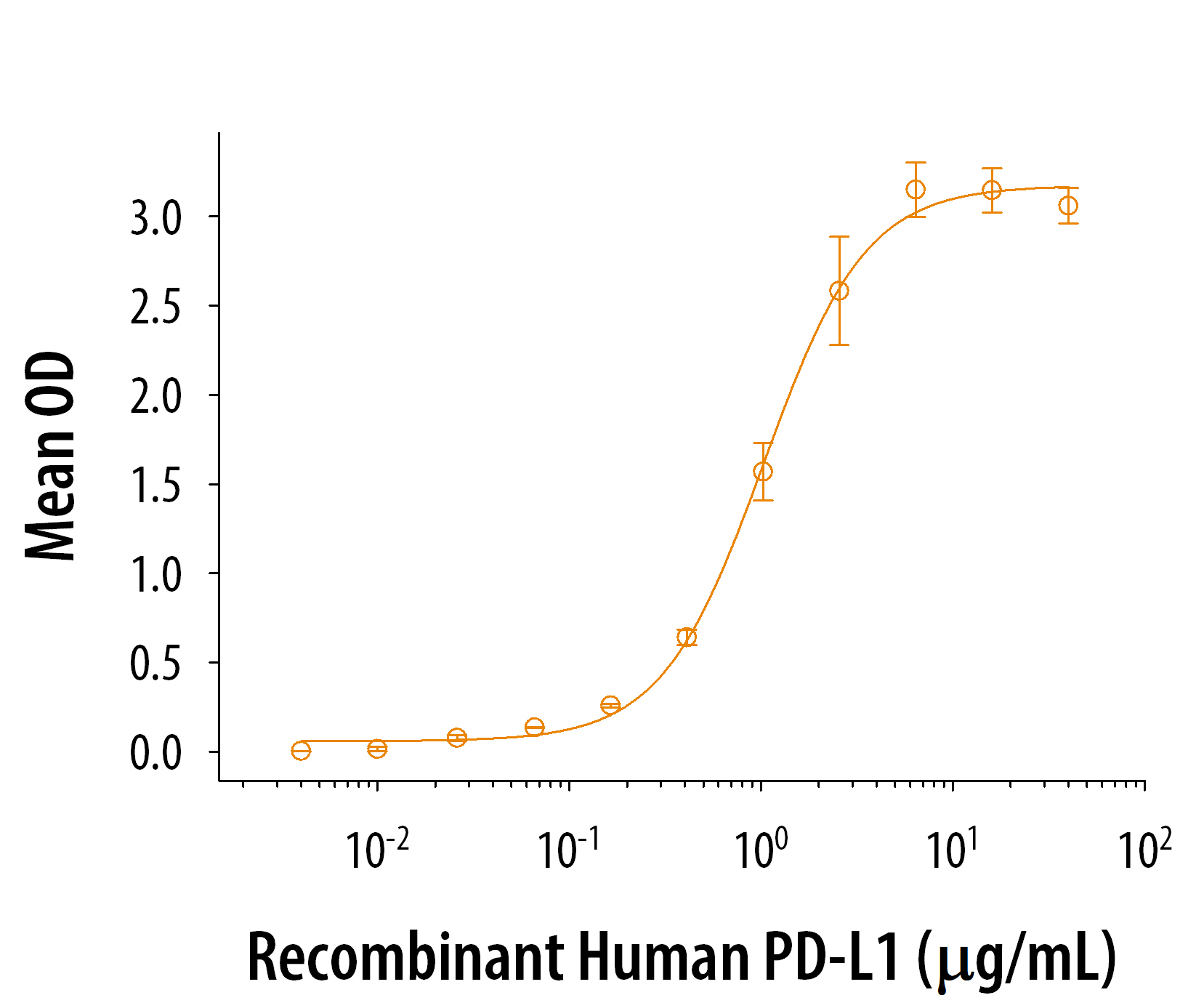Recombinant Human PD-1 His Tagged Protein, CF
Recombinant Human PD-1 His Tagged Protein, CF Summary
Product Specifications
Leu25-Thr168, with a C-terminal 6-His tag
Analysis
Product Datasheets
Carrier Free
CF stands for Carrier Free (CF). We typically add Bovine Serum Albumin (BSA) as a carrier protein to our recombinant proteins. Adding a carrier protein enhances protein stability, increases shelf-life, and allows the recombinant protein to be stored at a more dilute concentration. The carrier free version does not contain BSA.
In general, we advise purchasing the recombinant protein with BSA for use in cell or tissue culture, or as an ELISA standard. In contrast, the carrier free protein is recommended for applications, in which the presence of BSA could interfere.
8986-PD
| Formulation | Lyophilized from a 0.2 μm filtered solution in PBS. |
| Reconstitution | Reconstitute at 400 μg/mL in PBS. |
| Shipping | The product is shipped at ambient temperature. Upon receipt, store it immediately at the temperature recommended below. |
| Stability & Storage: | Use a manual defrost freezer and avoid repeated freeze-thaw cycles.
|
Scientific Data
 View Larger
View Larger
Recombinant Human PD-1 (Catalog # 8986-PD) has a molecular weight (MW) of 26.6 kDa as analyzed by SEC-MALS, suggesting that this protein is a monomer. MW may differ from predicted MW due to post-translational modifications (PTMs) present (i.e. Glycosylation).
 View Larger
View Larger
Reconstitution Calculator
Background: PD-1
Programmed Death-1 receptor (PD-1), also known as CD279, is type I transmembrane protein belonging to the CD28 family of immune regulatory receptors (1). Other members of this family include CD28, CTLA-4, ICOS, and BTLA (2-5). Mature human PD-1 consists of a 148 amino acid (aa) extracellular region (ECD) with one immunoglobulin-like V-type domain, a 24 aa transmembrane domain, and a 95 aa cytoplasmic region. The human PD-1 ECD shares 65% aa sequence identity with the mouse PD-1 ECD. The cytoplasmic tail contains two tyrosine residues that form the immunoreceptor tyrosine-based inhibitory motif (ITIM) and immunoreceptor tyrosine-based switch motif (ITSM) that are important for mediating PD-1 signaling. PD-1 acts as a monomeric receptor and interacts in a 1:1 stoichiometric ratio with its ligands PD-L1 (B7-H1) and PD-L2 (B7-DC) (6, 7). PD‑1 is expressed on activated T cells, B cells, monocytes, and dendritic cells while PD-L1 expression is constitutive on the same cells and also on nonhematopoietic cells such as lung endothelial cells and hepatocytes (8, 9). Ligation of PD-L1 with PD-1 induces co-inhibitory signals on T cells promoting their apoptosis, anergy, and functional exhaustion (10). Thus, the PD-1: PD-L1 interaction is a key regulator of the threshold of immune response and peripheral immune tolerance (11). Finally, blockade of the PD-1: PD-L1 interaction by either antibodies or genetic manipulation accelerates tumor eradication and shows potential for improving cancer immunotherapy (12, 13, 14).
- Ishida, Y. et al. (1992) EMBO J. 11:3887.
- Sharpe, A.H. and G. J. Freeman (2002) Nat. Rev. Immunol. 2:116.
- Coyle, A. and J. Gutierrez-Ramos (2001) Nat. Immunol. 2:203.
- Nishimura, H. and T. Honjo (2001) Trends Immunol. 22:265.
- Watanabe, N et al. (2003) Nat. Immunol. 4:670.
- Zhang, X. et al. (2004) Immunity 20:337.
- Lázár-Molnár, E. et al. (2008) Proc. Natl. Acad. Sci. USA 105:10483.
- Nishimura, H et al. (1996) Int. Immunol. 8:773.
- Keir, M.E. et al. (2008) Annu. Rev. Immunol. 26:677.
- Butte, M.J. et al. (2007) Immunity 27:111.
- Okazaki, T. et al. (2013) Nat. Immunol. 14:1212.
- Iwai, Y. et al. (2002) Proc. Natl. Acad. Sci. USA 99: 12293.
- Nogrady, B. (2014) Nature 513:S10.
- Swaika, A. et al. (2015) Mol. Immunol. 67: 4
Citations for Recombinant Human PD-1 His Tagged Protein, CF
R&D Systems personnel manually curate a database that contains references using R&D Systems products. The data collected includes not only links to publications in PubMed, but also provides information about sample types, species, and experimental conditions.
7
Citations: Showing 1 - 7
Filter your results:
Filter by:
-
Antibody-dependent cellular cytotoxicity-null effector developed using mammalian and plant GlycoDelete platform
Authors: CE Kang, S Lee, T Ahn, DH Seo, BJ Ko, M Jung, J Lee, JY Kim, WT Kim
Scientific Reports, 2022-11-08;12(1):19030.
Species: Human
Sample Types:
Applications: Bioassay -
Highly efficient hybridoma generation and screening strategy for anti-PD-1 monoclonal antibody development
Authors: T Phakham, C Boonkrai, T Wongtangpr, T Audomsun, C Attakitban, P Saelao, P Muanwien, S Sooksai, N Hirankarn, T Pisitkun
Scientific Reports, 2022-10-22;12(1):17792.
Species: Mouse
Sample Types: In Vivo
Applications: In Vivo -
Structural basis of HLX10 PD-1 receptor recognition, a promising anti-PD-1 antibody clinical candidate for cancer immunotherapy
Authors: H Issafras, S Fan, CL Tseng, Y Cheng, P Lin, L Xiao, YJ Huang, CH Tu, YC Hsiao, M Li, YH Chen, CH Ho, O Li, Y Wang, S Chen, Z Ji, E Zhang, YT Mao, E Liu, S Yang, W Jiang
PLoS ONE, 2021-12-31;16(12):e0257972.
Species: Human
Sample Types: Protein
Applications: Bioassay -
The multi-specific VH-based Humabody CB213 co-targets PD1 and LAG3 on T cells to promote anti-tumour activity
Authors: CJ Edwards, A Sette, C Cox, B Di Fiore, C Wyre, D Sydoruk, D Yadin, P Hayes, S Stelter, PD Bartlett, M Zuazo, MJ Garcia-Gra, G Benedetti, S Fiaska, NR Birkett, Y Teng, C Enever, H Arasanz, A Bocanegra, L Chocarro, G Fernandez, R Vera, B Archer, I Osuch, M Lewandowsk, YM Surani, G Kochan, D Escors, J Legg, AJ Pierce
British Journal of Cancer, 2021-12-30;0(0):.
Species: Human
Sample Types: Protein
Applications: Bioassay -
Fenebrutinib in H1 antihistamine-refractory chronic spontaneous urticaria: a randomized phase 2 trial
Authors: M Metz, G Sussman, R Gagnon, P Staubach, T Tanus, WH Yang, JJ Lim, HJ Clarke, J Galanter, LW Chinn, T Chu, A Teterina, T Burgess, DJ Haddon, TT Lu, M Maurer
Nature Medicine, 2021-11-08;27(11):1961-1969.
Species: Human
Sample Types: Serum
Applications: Bioassay -
Assessing the binding properties of the anti-PD-1 antibody landscape using label-free biosensors
Authors: ME Brown, D Bedinger, A Lilov, P Rathanaswa, M Vásquez, S Durand, I Wallace-Mo, L Zhong, JH Nett, I Burnina, I Caffry, H Lynaugh, M Sinclair, T Sun, J Bukowski, Y Xu, YN Abdiche
PLoS ONE, 2020-03-05;15(3):e0229206.
Species: Human
Sample Types: Reference Standard
Applications: Bioassay -
Reshaping Nanobodies for affinity purification on protein A
Authors: M Crauwels, N Van Vaeren, B Kulaya Nee, C Vincke, M D'Huyvette, N Devoogdt, S Muylderman, C Xavier
N Biotechnol, 2020-01-27;0(0):.
Species: Human
Sample Types: Protein
Applications: Surface Plasmon Resonance (SPR
FAQs
No product specific FAQs exist for this product, however you may
View all Proteins and Enzyme FAQsReviews for Recombinant Human PD-1 His Tagged Protein, CF
Average Rating: 4.8 (Based on 10 Reviews)
Have you used Recombinant Human PD-1 His Tagged Protein, CF?
Submit a review and receive an Amazon gift card.
$25/€18/£15/$25CAN/¥75 Yuan/¥2500 Yen for a review with an image
$10/€7/£6/$10 CAD/¥70 Yuan/¥1110 Yen for a review without an image
Filter by:
Reason for Rating: Good binding of PD-1-his tag with PDL1-Fc by Octet
Reason for Rating: This protein was used for a multitude of assays, including mouse immunizations, cell sorting, and Octet/binding assays (image of this assay included). The protein has performed well for all assays tested.
An anti-PD1 antibody was tested for binding to PD-1-His using ForteBio Octet, and the antibody bound specifically.


